Experimental Investigation on the Imbibition Behavior of Nanofluids in the Tight Oil and Gas Reservoir through the Application of Nuclear Magnetic Resonance Method
Abstract
:1. Introduction
2. Experimental Materials and Methods
2.1. Experimental Materials and Instruments
2.1.1. Materials
2.1.2. Characterization of Nanomaterials
2.1.3. Instrument
2.2. Experimental Program
2.2.1. Nuclear Magnetic Resonance Theory
2.2.2. Experimental Procedures
- (1)
- The cores were washed with oil, dried, weighed, and the gas-measured permeability and porosity were determined;
- (2)
- The cores were vacuum-saturated with water (24 h), weighed, and the NMR T2 profiles and 2D imaging in the saturated water state were determined;
- (3)
- The cores were dried (24 h), weighed, and saturated with fluorine oil (24 h), weighed, and the 2D imaging in the saturated fluorine oil state was determined;
- (4)
- The cores were put into water, nanoemulsion (0.02 ωt%), and 2D nano blackcard (0.005 ωt%) solution, respectively. The imbibition of the imbibition cores was observed at different times, and the oil volume was recorded at the same time;
- (5)
- The imbibition ends of the core sample were observed when the oil volume did not change. The surface of the core was dried. Then, the core was wrapped with plastic wrap and put it into the NMR instrument for the NMR T2 spectrum test. After the test, the two-dimensional pseudocolor imaging test was performed immediately. During the two-dimensional pseudocolor imaging test, the lateral center layer of the core was selected as the imaging operation layer, and the two-dimensional pseudocolor image was inverted by using the NMR signal changes in different areas of the core center plane;
- (6)
- The data was processed, images were drawn, and the experimental results were analyzed.
3. Analysis of the Results
3.1. Analysis of the Results of NMR Experiments
3.1.1. Pore Throat Characteristics and Fluid Distribution Based on T2 Spectrum
3.1.2. Analysis of Imbibition Results Based on Two-Dimensional Imaging
3.2. Results Analysis of Mass Method with Nuclear Magnetic Resonance Experiment
3.3. Volume Method Calculation Results and Results Analysis
4. Conclusions
- (1)
- Analysis of the T2 spectrum after saturating it with water shows that in the low-permeability sandstones, the distribution of medium and small pore throats is widely accounted for (about 60%), and the distribution of large pore throats is less than about 30%. These are the typical distribution characteristics of ultra-low-permeability sandstone NMR T2 spectra;
- (2)
- In the imbibition process, combined with the T2 spectrum, although the water and water-based imbibition fluid entered the core from the small and medium pore throats due to capillary force, the fluorine oil tends to flow out of the core from the large pore throats, and the residual fluorine oil is mainly distributed in the small and medium pore throats;
- (3)
- The 2D pseudocolor imaging results show that the imbibition liquid enters the core evenly, the imbibition liquid surface advances relatively uniformly, and no obvious dominant imbibition channel is formed. It shows that the spontaneous imbibition of low-permeability sandstone not only occurs on the core surface, but also has an effect on the deep pore throats;
- (4)
- Comparing the imbibition results of the positive and negative directions, it is found that there is no obvious end-face enrichment phenomenon during the spontaneous imbibition, and the imbibition is uniform in all directions. This indicates that the capillary force plays a leading role in the imbibition process, and that the effects of gravity and buoyancy are weak;
- (5)
- During the imbibition experiment, adding nanomaterials improved the wettability of the core surface, thereby accelerating the imbibition efficiency, which is due to the adsorption of nanoparticles on the core surface. Comparing the imbibition effects of the three imbibition liquids (the 2D nano black card can significantly improve the recovery degree up to 25.1%), it provides an effective reference for the practical application of low-permeability oilfield development.
Author Contributions
Funding
Institutional Review Board Statement
Informed Consent Statement
Data Availability Statement
Conflicts of Interest
References
- Qu, Z.H.; Kong, L.R. Microscopic water-driven oil characteristics of low-permeability oil formations. J. Northwestern Univ. (Nat. Sci. Ed.) 2002, 4, 329–334. [Google Scholar]
- Yang, W.S. Study on Dynamic Imbibition and Expulsion Law of Tight Reservoirs; China University of Petroleum: Beijing, China, 2018. [Google Scholar]
- Cai, J.C.; Yu, B.M. Research progress on spontaneous imbibition in porous media. Adv. Mech. 2012, 42, 735–754. [Google Scholar]
- Li, J.S. Effect of Surfactant System on Imbibition Process; Graduate School of Chinese Academy of Sciences (Institute of Percolation Fluid Mechanics): China, Beijing, 2006. [Google Scholar]
- Chen, C.; Wang, S.; Kadhum, M.J.; Harwell, J.H.; Shiau, B.J. Using carbonaceous nanoparticles as surfactant carrier in enhanced oil recovery: A laboratory study. Fuel 2018, 222, 561–568. [Google Scholar] [CrossRef]
- Cheng, Z.; Wang, Q.; Ning, Z.; Li, M.; Lyu, C.; Huang, L.; Wu, X. Experimental Investigation of Countercurrent Spontaneous Imbibition in Tight Sandstone Using Nuclear Magnetic Resonance. Energy Fuels 2018, 32, 6507–6517. [Google Scholar] [CrossRef]
- Zhou, Y.; Pu, H.; Zhong, X.; Li, C.C.; Zhang, S.J.; Sun, R.X. Visualization experiment of nanoparticle imbibition oil recovery in Hele-Shaw model. Daqing Pet. Geol. Dev. 2019, 38, 6. [Google Scholar]
- Li, Y.; Dai, C.; Zhou, H.; Wang, X.; Lv, W.; Zhao, M. Investigation of Spontaneous Imbibition by Using a Surfactant-Free Active Silica Water-Based Nanofluid for Enhanced Oil Recovery. Energy Fuels 2018, 32, 287–293. [Google Scholar] [CrossRef]
- Roustaei, A. An Evaluation of Spontaneous Imbibition of Water into Oil-Wet Carbonate Reservoir Cores Using Nanofluid. Petrophysics 2014, 55, 31–37. [Google Scholar]
- Karimi, A.; Fakhroueian, Z.; Bahramian, A.; Pour Khiabani, N.; Darabad, J.B.; Azin, R.; Arya, S. Wettability Alteration in Carbonates using Zirconium Oxide Nanofluids: EOR Implications. Energy Fuels 2012, 26, 1028–1036. [Google Scholar]
- Bayat, A.E.; Junin, R.; Samsuri, A.; Piroozian, A.; Hokmabadi, M. Impact of Metal Oxide Nanoparticles on Enhanced Oil Recovery from Limestone Media at Several Temperatures. Energy Fuels 2014, 28, 6255–6266. [Google Scholar] [CrossRef]
- Ehtesabi, H.; Ahadian, M.M.; Taghikhani, V.; Ghazanfari, M.H. Enhanced Heavy Oil Recovery in Sandstone Cores Using TiO2 Nanofluids. Energy Fuels 2013, 28, 423–430. [Google Scholar] [CrossRef]
- Yang, J. Analysis on the mechanism of porous media imbibition and its influencing factors. Yunnan Chem. Ind. 2020, 47, 3. [Google Scholar]
- Wang, X.X. Study on imbibition mechanism and development of low permeability reservoirs. Adv. Fine Petrochem. 2017, 18, 4. [Google Scholar]
- Shi, Y.H. Study on Imbibition o Fracturing Fluid in Chang 7 Reservoir Based on Nuclear Magnetic Resonance; Xi’an Petroleum University: Xi’an, China, 2018. [Google Scholar]
- Pu, Y.; Wang, X.Y.; Yang, S.L. Using NMRI technology to study the static imbibition mechanism of tight reservoirs. J. Petrochem. Univ. 2017, 1, 48–51, 56. [Google Scholar]
- Dang, H.L.; Wang, X.F.; Cui, P.X.; Hou, F.C.; Li, T. Research on imbibition and oil displacement characteristics of low-permeability tight sandstone reservoirs based on nuclear magnetic resonance technology. Prog. Geophys. 2020, 35, 129–139. [Google Scholar]
- Chen, Y.X. Study on Imbibition Experiment and Numerical Simulation of Yanchang Tight Oil Reservoir; China University of Geosciences: Beijing, China, 2020. [Google Scholar]
- Dai, C.; Cheng, R.; Sun, X.; Liu, Y.; Zhou, H.; Wu, Y.; You, Q.; Zhang, Y.; Sun, Y. Oil migration in nanometer to micrometer sized pores of tight oil sandstone during dynamic surfactant imbibition with online NMR. Fuel 2019, 245, 544–553. [Google Scholar] [CrossRef]
- Hun, L.; Shicheng, Z.; Fei, W.; Ziqing, P.; Jianye, M.; Tong, Z.; Zongxiao, R. Experimental Investigation on Imbibition-Front Progression in Shale Based on Nuclear Magnetic Resonance. Energy Fuel 2016, 30, 9097–9105. [Google Scholar] [CrossRef]
- Zhou, H.; Zhang, Q.; Dai, C.; Li, Y.; Lv, W.; Wu, Y.; Cheng, R.; Zhao, M. Experimental investigation of spontaneous imbibition process of nanofluid in ultralow permeable reservoir with nuclear magnetic resonance. Chem. Eng. Sci. 2019, 201, 212–221. [Google Scholar] [CrossRef]
- Cannon, D.E.; Minh, C.; Kleinberg, R.L. Quantitative NMR Interpretation. In Proceedings of the SPE Annual Technical Conference and Exhibition, New Orleans, LA, USA, 27–30 September 1998; OnePetro: Richardson, TX, USA, 1998. [Google Scholar]
- Kleinberg, R.L. Utility of NMR T 2 distributions, connection with capillary pressure, clay effect, and determination of the surface relaxivity parameter ρ2. Magn. Reson. Imaging 1996, 14, 761–767. [Google Scholar] [CrossRef]
- Zhao, P.; Wang, Z.; Sun, Z.; Cai, J.; Wang, L. Investigation on the pore structure and multifractal characteristics of tight oil reservoirs using NMR measurements: Permian Lucaogou Formation in Jimusaer Sag, Junggar Basin. Mar. Pet. Geol. 2017, 86, 1067–1081. [Google Scholar] [CrossRef]
- Liu, J.; Sheng, J.J. Experimental investigation of surfactant enhanced spontaneous imbibition in Chinese shale oil reservoirs using NMR tests. J. Ind. Eng. Chem. 2019, 72, 414–422. [Google Scholar]
- Liu, T.Y.; Wang, S.M.; Fu, R.S.; Zhou, M.S.; Li, Y.H.; Luo, M. Analysis of rock pore throat structure by nuclear magnetic resonance spectroscopy. Pet. Geophys. Explor. 2003, 18, 737–742. [Google Scholar]
- Guo, G.J.; Gu Chang, C. Nuclear Magnetic Resonance Experimental Study on Pore Production Law of Water-flooding Oil. J. Xi’an Shiyou Univ. (Nat. Sci. Ed.) 2005, 9–10, 57–60. [Google Scholar]
- Yun, H.Y.; Zhao, W.J.; Liu, B.K.; Zhou, C.C.; Zhou, F.M. Study on rock pore structure based on T2 distribution. Logging Technol. 2002, 18–21, 89. [Google Scholar] [CrossRef]
- He, Y.D.; Mao, Z.Q.; Xiao, L.Z.; Ren, X.J. An improved method for evaluating rock pore size distribution by nuclear magnetic resonance T2 distribution. Acta Geophys. 2005, 2, 373–378. [Google Scholar]
- Li, H.B.; Zhu, J.Y.; Guo, H.K. Research on the distribution of pore radius converted from nuclear magnetic resonance T2 spectrum. J. Spectrosc. 2008, 273–280. [Google Scholar]
- Lang, D.J.; Shang, G.H.; Lv, C.Y.; Ding, S.Q.; Sun, A.J.; Shan, X.L. Experiment and application of NMR analysis method for carbonate reservoirs—Take Tahe Oilfield as an example. Pet. Nat. Gas Geol. 2009, 30, 363–369. [Google Scholar]
- Ju, M.S.; Wang, X.Y.; Yu, W.S.; Yang, S.L.; Ye, W.Z.; Zhang, T.Q. Static imbibition law of tight reservoirs based on nuclear magnetic resonance technology. Xinjiang Pet. Geol. 2019, 40, 334–339. [Google Scholar]
- Zhao, M.W.; Liu, S.C.; Li, Y.; Song, X.G.; Yan, R.Q. Comprehensive experimental design for detecting the distribution characteristics of crude oil in cores by nuclear magnetic resonance T2 spectroscopy and imaging technology. Exp. Technol. Manag. 2021, 38, 4. [Google Scholar]
- Su, Y.B.; Lin GY Han, Y. Effects of surfactants on spontaneous imbibition and oil displacement in tight sandstone reservoirs. Fault Block Oil Gas Fields 2017, 24, 4. [Google Scholar]
- Nowrouzi, I.; Manshad, A.K.; Mohammadi, A.H. Effects of concentration and size of TiO2 nano-particles on the performance of smart water in wettability alteration and oil production under spontaneous imbibition. J. Pet. Sci. Eng. 2019, 183, 106357. [Google Scholar] [CrossRef]
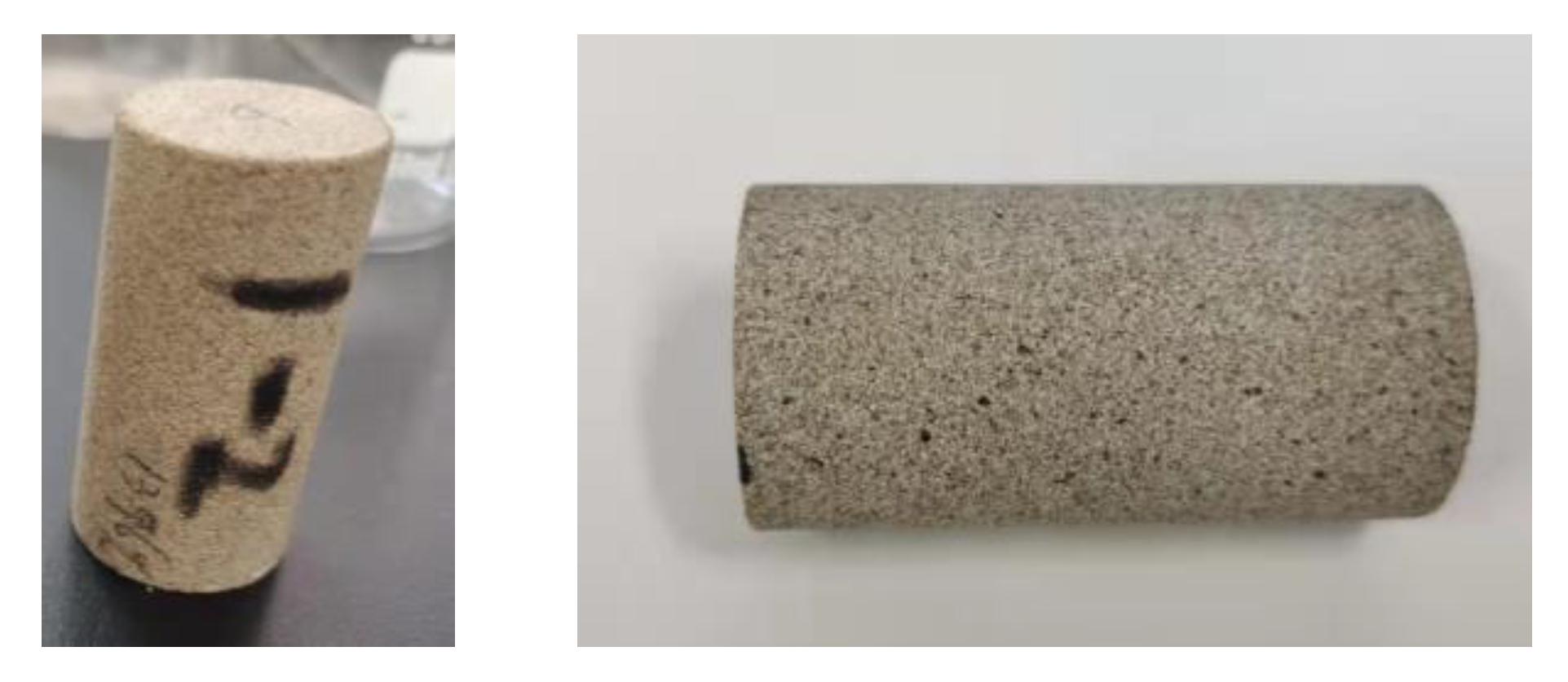


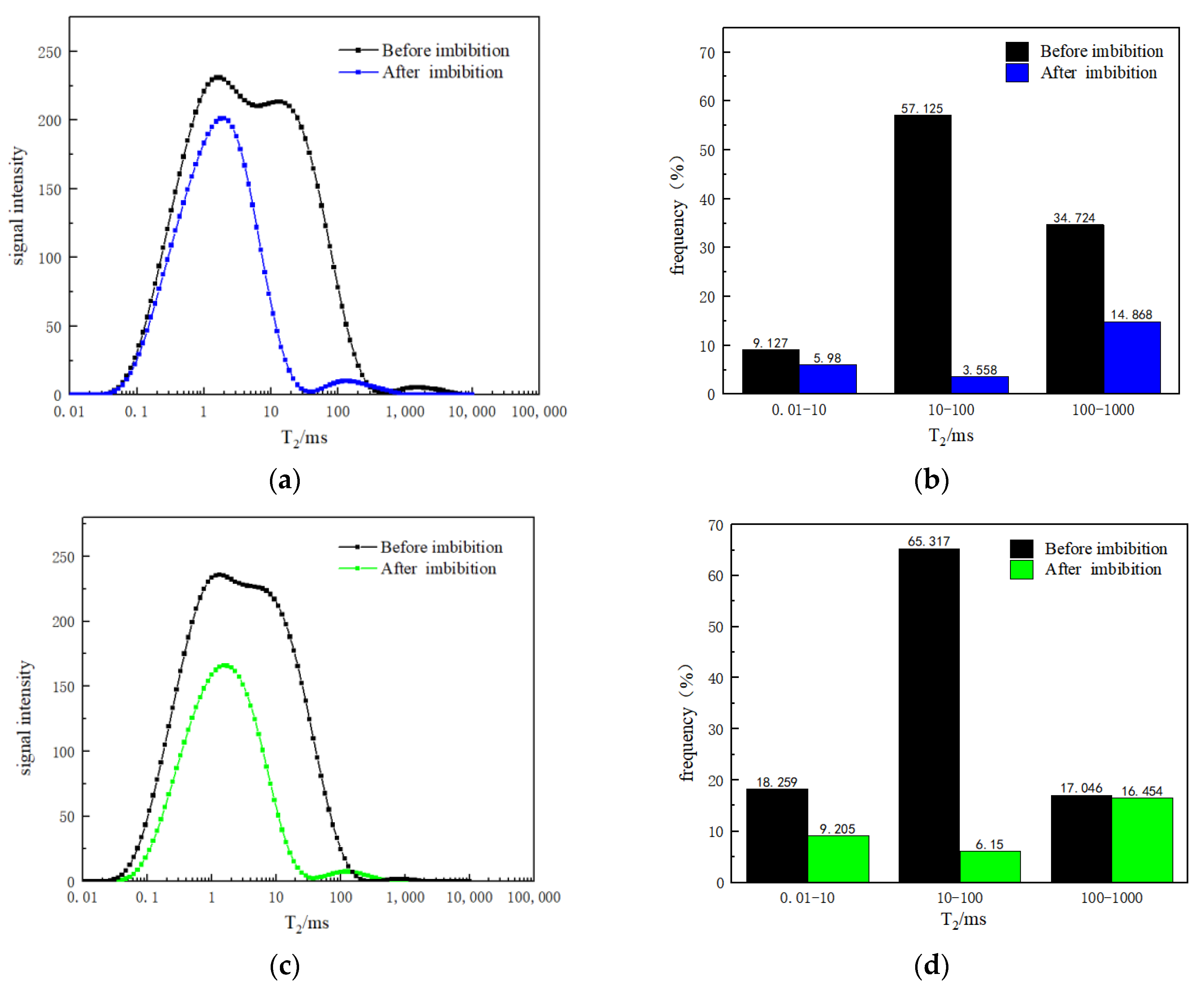
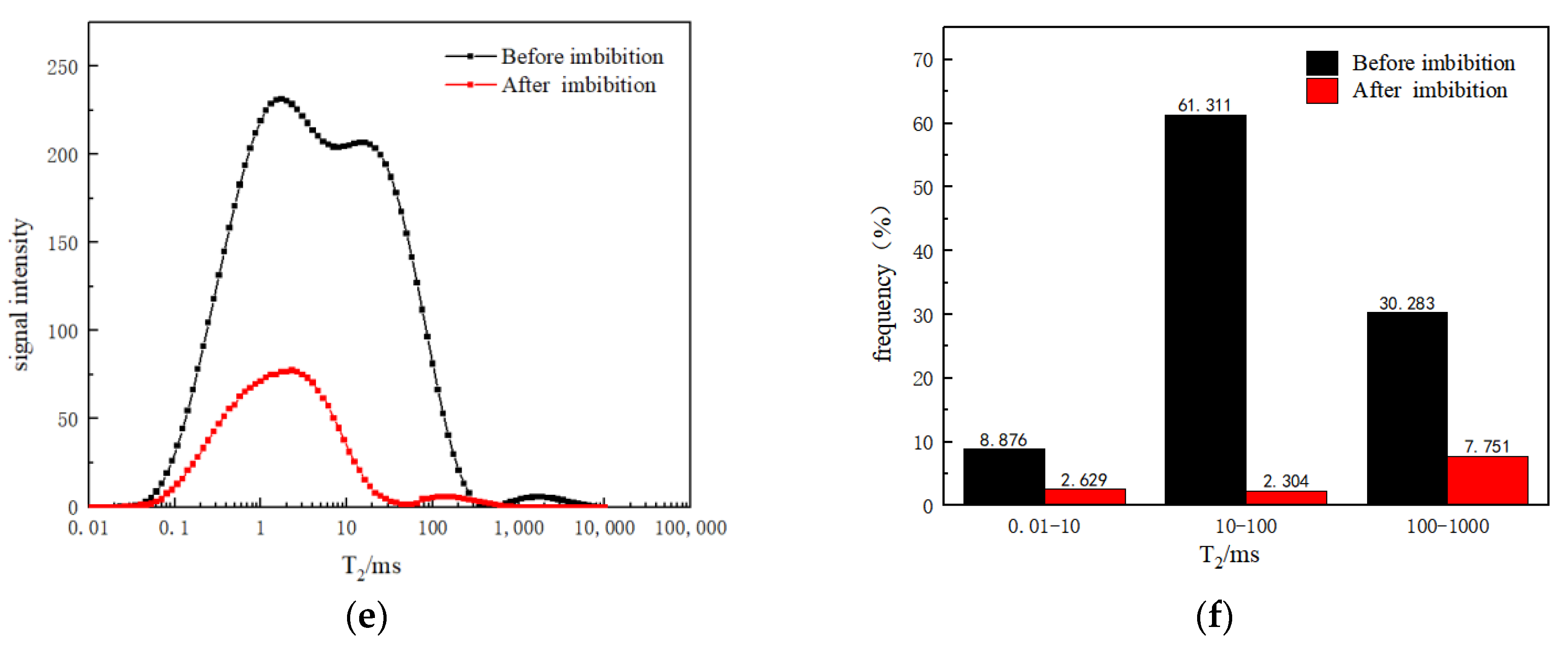
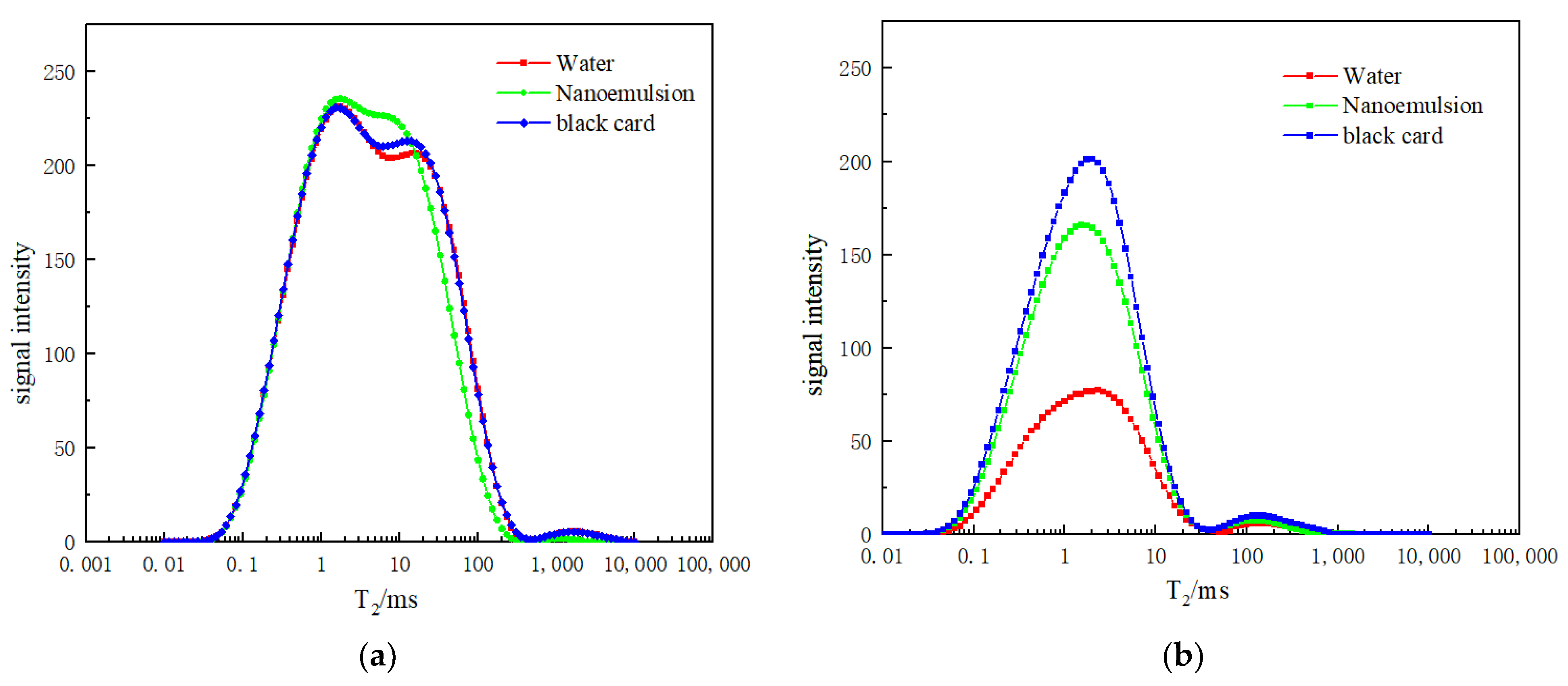
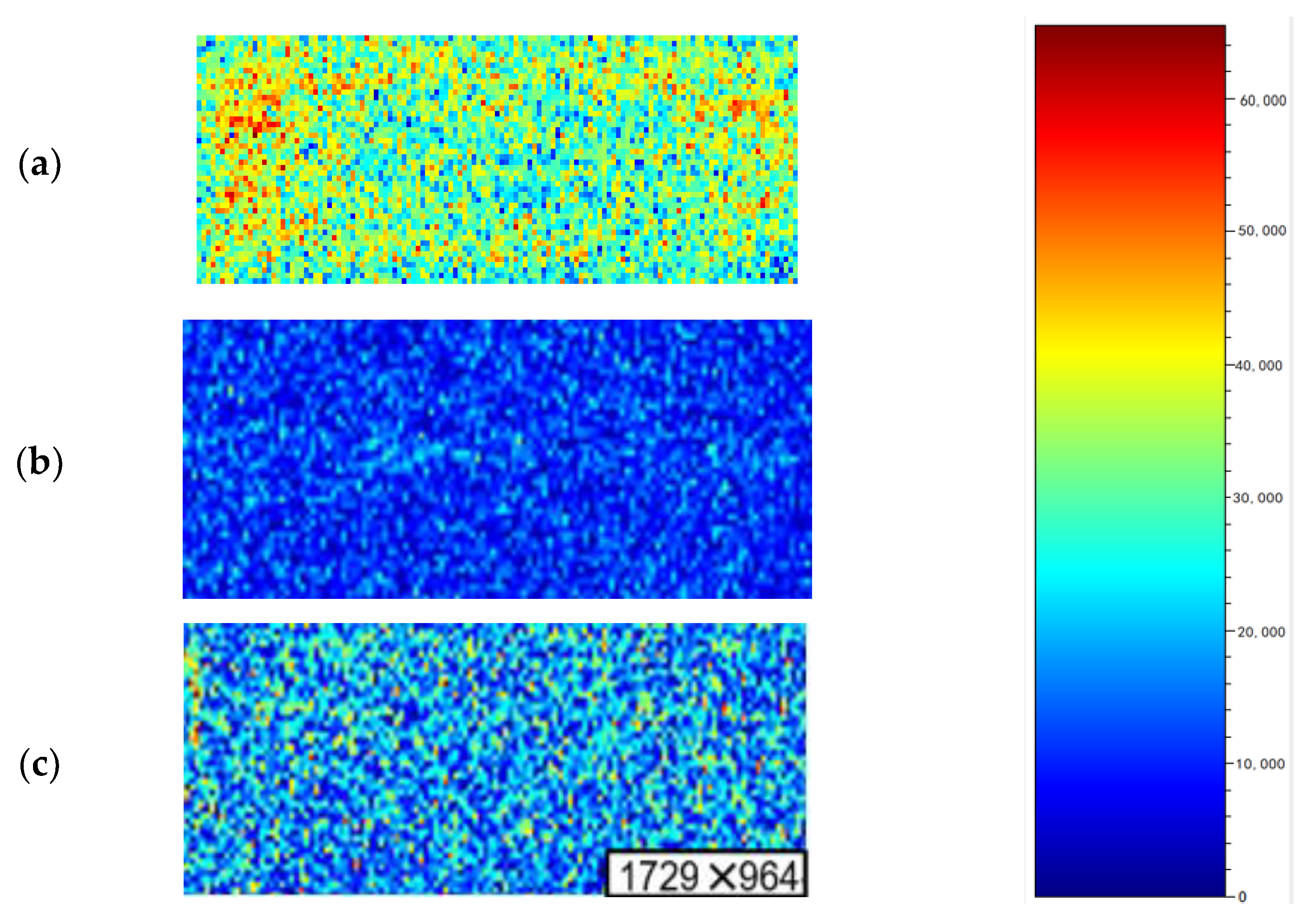
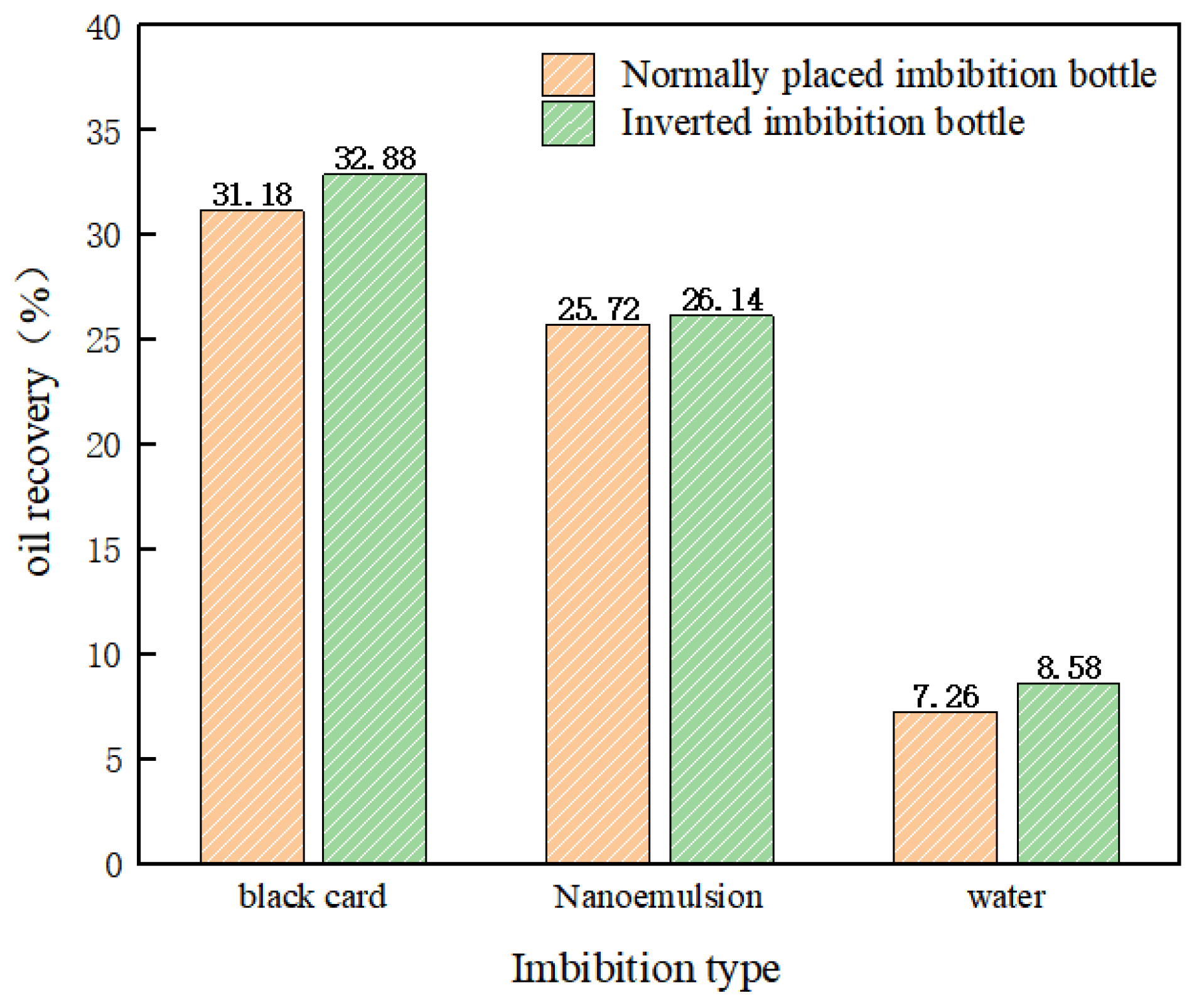

| Core Number | Length (cm) | Diameter (cm) | Porosity (%) | Permeability (mD) |
|---|---|---|---|---|
| 1–1 | 4.906 | 2.515 | 13.96 | 3.4502 |
| 1–2 | 4.940 | 2.525 | 13.38 | 3.2281 |
| 2–1 | 4.880 | 2.525 | 12.05 | 2.6480 |
| 2–2 | 4.911 | 2.515 | 14.65 | 1.9110 |
| 3–1 | 4.900 | 2.525 | 13.96 | 3.3075 |
| 3–2 | 4.967 | 2.525 | 12.36 | 2.8610 |
| 3–3 | 4.971 | 2.515 | 14.75 | 2.9370 |
| T2 Relaxation Time/ms | Pore Radius/μm | Pore Type |
|---|---|---|
| T2 ≤ 1 | ≤2 | Micropore |
| 1 < T2 ≤ 10 | 2 < r ≤ 10 | Small pore |
| 10 < T2 ≤ 100 | 10 < r ≤ 20 | Middle pore |
| 100 < T2 ≤ 1000 | 20 < r ≤ 200 | Large pore |
Disclaimer/Publisher’s Note: The statements, opinions and data contained in all publications are solely those of the individual author(s) and contributor(s) and not of MDPI and/or the editor(s). MDPI and/or the editor(s) disclaim responsibility for any injury to people or property resulting from any ideas, methods, instructions or products referred to in the content. |
© 2022 by the authors. Licensee MDPI, Basel, Switzerland. This article is an open access article distributed under the terms and conditions of the Creative Commons Attribution (CC BY) license (https://creativecommons.org/licenses/by/4.0/).
Share and Cite
Li, H.; Wang, C.; Li, B.; Wen, X.; Li, J.; Tian, L. Experimental Investigation on the Imbibition Behavior of Nanofluids in the Tight Oil and Gas Reservoir through the Application of Nuclear Magnetic Resonance Method. Energies 2023, 16, 454. https://doi.org/10.3390/en16010454
Li H, Wang C, Li B, Wen X, Li J, Tian L. Experimental Investigation on the Imbibition Behavior of Nanofluids in the Tight Oil and Gas Reservoir through the Application of Nuclear Magnetic Resonance Method. Energies. 2023; 16(1):454. https://doi.org/10.3390/en16010454
Chicago/Turabian StyleLi, Hui, Can Wang, Ben Li, Xixia Wen, Jianchuan Li, and Lu Tian. 2023. "Experimental Investigation on the Imbibition Behavior of Nanofluids in the Tight Oil and Gas Reservoir through the Application of Nuclear Magnetic Resonance Method" Energies 16, no. 1: 454. https://doi.org/10.3390/en16010454
APA StyleLi, H., Wang, C., Li, B., Wen, X., Li, J., & Tian, L. (2023). Experimental Investigation on the Imbibition Behavior of Nanofluids in the Tight Oil and Gas Reservoir through the Application of Nuclear Magnetic Resonance Method. Energies, 16(1), 454. https://doi.org/10.3390/en16010454





